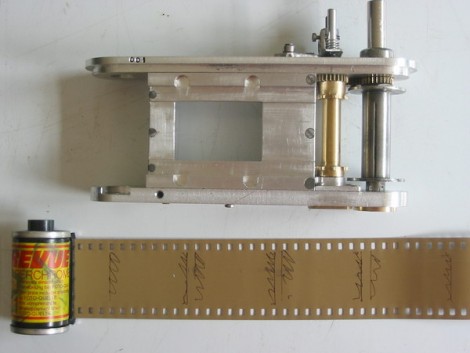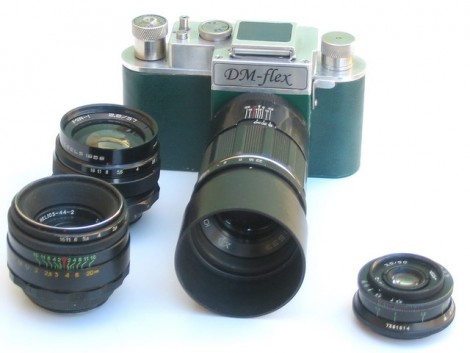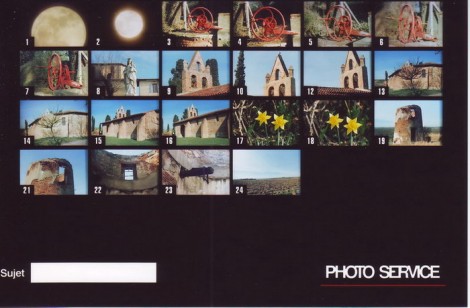
It took us a while to stop drooling long enough to write about this amazing machining project. [Denis MO] made a single-lens reflex camera from scratch. The banner image above is not the finished product, but just one step in the production chain. [Denis] has been thinking about doing this project for 25 years and finally took the plunge. From the start, the only parts he planned on NOT making himself were the screws, ball bearings, shutter, curtain fabric, and interchangeable lenses. Everything else is his own creation based off of his own design. Spend some time looking over his project. There’s plenty of information and images of both the machining process, and the drawings he mocked up in the design process. We’ve also included a pic of the finished camera and the contact sheet from his test roll of film after the break.


[Thanks Javi]
















Wow that is impressive.
WOW… Just WOW.
Looks Russian!
Woah
This must be the most amazing thing I’ve seen in a while.I was just about to say the same thing as Fallen and craig christ but I said I shouldn’t sound like broken record — but then again… WOW
That is truly awesome. To see someone with access to machinery and actually use it to create something they like is very rare. Nice job.
Just spent a good 30 mins trawling through all those images, absolutely astounding work. I honestly would never understand where to start a project like this, let alone the patience.
OMFG he is also building a rangefinder camera O_O
This is just gorgeous. Home-made gears, body, casing, mount. I am in awe.
The only problem is: now I want a machine shop to go along with my cameras.
Holy crap.
I like how the first two shots on the roll of film are of the moon. True hacker style, I’m guessing he finished the thing late at night, and couldn’t wait to load it up and test it out.
And yeah, as Ted Zissou said, it does kind of look like a refined Zenit or Zorki from fifty years ago. (This coming from someone who still regularly uses a Zorki, BTW.)
Quite Impressive!!
Nice machine work – but kind of like making your own mimeograph machine. Best stock up on film while it’s still being produced.
Fantastic piece of work. What is next? Adapting a digital back for this awesome camera?
Wow… that is beyond impressive. That is something to really be proud of! Good job man!
My first thought was “so what” – film is dead. I then looked at the links.
WOW!
The build documentation and pics are great.
That is the BALLS!
Holy sh*t, that’s some really nice work. Is it heavy in any way? The pics that came out look really good as well, I just don’t know what else to say.
For the record, is that an M42 or M39 mount on there??
Now all we need is someone to come up with a hack to produce your own film for the thing then we will have truely “open source” photography (if you build your own dark room that is)
there are “open source” developers (film developers, haha) too – caffenol for example. It’s actually up to par with the commercial developers if not better! It would be great with a cheap way to manufacture film at home, sadly it isn’t possible in any way – getting a film speed over 25 or so is pretty impossible in a home made emulsion.
Amazing! Nice work and complete meat-and-potatoes building :) Keep up the great work and thank your wife for the time she lets ya have to do the projects :) They are the patient ones. I’m forwarding this article to a couple of my camerabug friends-should make them feel like n00bs lol. My wife loves the green leatherette finish. Should be the new black ;)
Absolutely awesome. Not only did he design it, he built it. I like his reason for attaching his lens mount with 5 screws instead of 4: “no one will think I used a Zenit mount”.
Very nice craftsmanship. My fingers are too fat to do what he has done.
Nifty, but that list of things he did not make means he just made a camera case and some rollers for the film, and I’m sure many metal workers are able to do that.
So chalk me off as semi-impressed :)
You mean this list?
shutter curtain fabric, ball bearings and screws
Incredible!!
Nice to see people still have the time and dedication to a single project to see it through completion and perfection. Awe-inspiring. Bravo!
Beautiful. That is an amazing piece of work, and the author was even kind enough to translate his post into English.
I wish I had the skills and dedication to put something like that together.
Yes travis, that list, I don’t mean to belittle it, it’s more skill than I ever have with metal working (I really fail at that, my boreholes are never centered no matter what I do for instance), but taking the shutter and such out of the equation it’s ‘just’ a skillfully done case and rollers from what I gather from glancing at the pictures.
So from my viewpoint impressive, but from people more adept at metalwork probably less so I expect.
When I was a boy, I did my first electronic PCB with dynamic LED lights. Proudly, I showed my realization to a person dear to me. He said with boredom: when you will be able to build your own chip then you’ll have the right to be proud. But those are already invented, I said… much later I learned from his wife that he also tried to learn electronics, took some classes then abandoned. He was green with envy on a little boy. I keep that in my heart, to never make the same mistake with my children.
Whatnot: Yeah, he “just” made a camera body, film advance mechanism, lens mount, mirror reflex assembly, pentaprism, and “some rollers for the film”, with positional accuracy on three axes to, you know, one thousandth of an inch or so. Heck, your average WoW player can do *that*! Obviously, if he’d manufactured his own screws, ball bearings, and fabric, *then* he’d be, y’know, cool.
FWIW, there *are* a few very insane people who coat their own 35mm film, but there are rather more who coat their own sheet or plate film. Given the relatively simple design of a basic plate camera, the only *real* hurdle to complete open-source camera hardware is the (extremely non-trivial) matter of producing a lens more complicated than a simple meniscus.
But if someone wants to develop the reprap version of an optical thin-film coating machine, capable of consistent and repeatable multilayer lens coating, that’d be a good start. :)
Astounding…My favorite part of the whole log (which I read every word) was where he talked about the stickers he printed for the adjustment dials because he didn’t have the time or the desire to build an engraving machine…thing is this guy could probably crank out a small cnc engraver in a couple hours!
This is the most impressive build I have ever seen!
Amazing work and dedication.
It made me think of the Nikon FM3 which is a hybrid mechanical/electronic camera but it was clear to Nikon when they designed it in 2001 that the know-how to design and manufacture certain mechanical items on a camera is getting very rare and hard to come by.
It’s a good read if you’re interested in cameras. Here is the link: http://imaging.nikon.com/products/imaging/technology/d-archives/history-fm3a/index.htm
@George I know people who went took very basic education in mechanics and the first thing they learned was machining stuff on a lathe, and if you have access to one then obviously high accuracy isn’t that hard for many parts like the rollers and spindles.
So yes am average WoW player could do that accuracy.
(I don’t even know what the average WoW player’s credentials would be, I know some MIT/RIT people play WoW though)
Now the whole project together that’s another matter and it takes some skill and dedication.
But be fair, isn’t the shutter the most complex part? (And the lens too but grinding lenses is a whole different field and I’d tend to exclude that from this discussion.)
Anyway it’s more than I could do and as I said I give the work done plenty of credit, I just put some reservations on it because as I said I know using a lathe is part of basic curriculum for mechanics.
Oh and incidentally, a $3 throwaway camera manages to advance film fine, there’s no big need to have the parts between the shots accurate to withing a millionths of a millimeter, it just should not overlap.
What’s more important is having the back where the film sits completely parallel to the lensmount at exactly the right distance, without play but still allowing the film to move between shots, and the lensmount being completely flat, now that’s more a challenge than simply advancing the film I would say, and there very high accuracy counts, and you can’t lathe it either.
Note: I am aware I made some editing errors like not removing ‘went’ when I changed the line to use ‘took’ instead.
Sorry about that.
pffft, he didnt build the lens from scratch. lazy.
jks, this is outrageous.
The single most complex part of a roll-film SLR camera is the shutter. The best all-mechanical SLRs use an extremely elaborate clockwork mechanism with a flyweight and stepped gears which actually controls the amount of time the shutter remains open. The old Leica mechanism this guy uses is much simpler but still quite a complex mechanism in execution.
Snappy.
You have got probably the greatest websites.|